At Home Upholstered Headboards: A Complete Guide
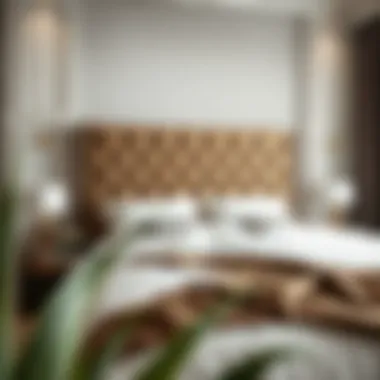
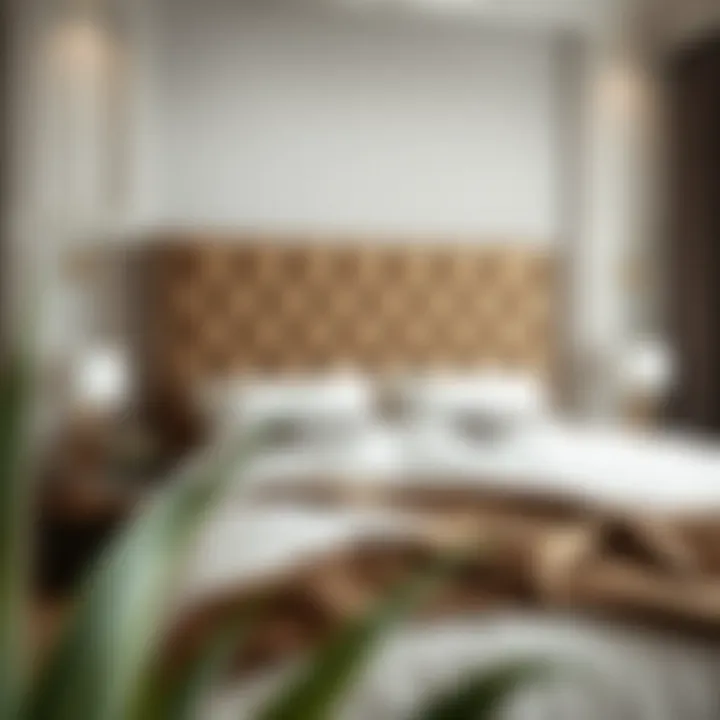
Intro
Upholstered headboards are not just decorative elements; they are the crowning jewels of bedroom design. These pieces blend form and function, offering both comfort and style, transforming a simple bed into a statement piece that draws the eye. In this guide, we explore the various facets of upholstered headboards — from their design styles to materials, DIY considerations, and maintenance tips. Whether you're a seasoned designer or a homeowner looking to enhance your living space, this resource is crafted to cater to your needs, adding that touch of elegance and functionality a bedroom truly deserves.
Furniture Design Styles
Finding the right style for your upholstered headboard can feel like looking for a needle in a haystack. The bed takes up a big chunk of bedroom real estate, and the headboard is pivotal in setting the mood. There are several popular styles to consider, and understanding them can make the selection process smoother.
Overview of Popular Styles
- Modern: Clean lines, minimalistic designs, and often features neutral colors. Think sleek fabrics and geometric shapes. Perfect for those who prefer a no-fuss aesthetic.
- Traditional: These headboards might feature tufting, intricate designs, and rich fabrics. Styles draw heavily on historical influences, evoking a sense of grandeur and warmth.
- Industrial: Blending wood and metal, industrial-style headboards have an earthy and raw vibe. This look is ideal for urban dwellers who appreciate a mix of rugged elements.
- Bohemian: Characterized by the use of vibrant colors and eclectic patterns, Boho headboards can often feel whimsical, adding character and a personal touch to any bedroom.
- Rustic: Wooden finishes, often joined with fabric or leather, create a cozy and inviting atmosphere. This style resonates with those who adore nature and a countryside feel.
Choosing the right style hinges on your existing decor as well.
How to Mix and Match Styles
Combining styles can be an art form in itself. Here are some tips on how to blend different aesthetics:
- Choose a Focal Point: Decide which element will dominate. Your upholstered headboard can serve as the visual anchor, so choose a bold color or intricate design that will stand out.
- Balance Is Key: Use contrasting materials but keep a balance in colors. If your headboard is ornate, pair it with simpler bedside tables to avoid visual clutter.
- Use Textures: Mixing textures can create depth. For instance, a velvet upholstered headboard paired with wooden accents can add that layered look.
- Limit the Color Palette: Keeping a cohesive palette helps in achieving a unified look. Stick to a few colors that complement each other well.
- Accessorize Thoughtfully: Throw pillows, blankets, or wall art around the bed can bring in a mixture of styles while tying everything together.
A well-mixed style can enhance the overall vibe of your bedroom, making it a true reflection of your personality.
Practical Tips for Homeowners
Once you’ve settled on a style for your upholstered headboard, here are some essential tips to make your experience enjoyable and hassle-free.
Essential Buying Tips
- Quality First: Invest in good quality materials. Not every headboard is created equal. A solid frame can withstand years of use, ensuring longevity.
- Measure Twice: Ensure the size fits your bed perfectly. A mismatched headboard can disrupt the harmony of your room's design.
- Consider Your Lifestyle: If you have pets or kids, durability is crucial. Fabrics that aren’t easily stained or marked may be a wise choice.
- Pick the Right Height: Depending on ceiling height and bed frame, consider the headboard's height to make sure it offers the right proportions in the room.
Maintenance and Care Guidelines
Taking care of your upholstered headboard can extend its lifespan significantly. Here are some simple tips to keep it looking new:
- Regular Cleaning: Dust and vacuum your headboard regularly to avoid dirt accumulation.
- Spot Treat Stains: Use a stain remover or simply a damp cloth to address spots quickly before they set in.
- Rotate and Adjust: Occasionally shift the headboard if it’s movable, helping to distribute wear and tear evenly.
- Avoid Direct Sunlight: If possible, keep the headboard out of direct sunlight to prevent fading.
Incorporating an upholstered headboard isn’t just about aesthetics — it's about crafting a cozy retreat that speaks to you. These tips and insights will serve you well whether you're stepping into DIY territory or venturing into a local design shop.
For more information, visit sources like Britannica or Wikipedia for an in-depth look at furniture styles and designs.
Prelude to Upholstered Headboards
Upholstered headboards are more than just decorative pieces; they play a crucial role in the overall composition of bedroom design. When one thinks about headboards, there’s an immediate association with comfort and stability, but upholstered variants add an extra layer of depth and style that can elevate a room's aesthetic. They are especially significant as they combine form and function, creating a seamless blend of luxury and practicality that many modern bedrooms require. Choosing the right upholstered headboard can enhance the ambiance, providing both visual interest and a cozy feel, contributing to more restful nights.
Defining Upholstered Headboards
Upholstered headboards typically consist of a supportive frame that is covered with padding and fabric. This results in a soft, cushioned surface, ideal for leaning against while reading or watching television. Unlike rigid headboards, upholstered options can incorporate various textures and colors, making them incredibly versatile. They are often crafted using materials like foam or batting underneath some covering fabric, such as linen or velvet. This construction allows for an element of plush comfort that hard materials simply cannot provide.
In terms of design, upholstered headboards can range from minimalist styles to flamboyant statement pieces. The beauty lies in their ability to adapt to different themes, be it modern, vintage, or something in-between, offering a myriad of possibilities for homeowners and designers alike. Each choice reflects personal style while enhancing the overall decor.
Historical Context
The history of upholstered headboards is rich, tracing back to as early as the Middle Ages when bed frames were often adorned with ornate textiles for added comfort. Woven fabrics were not merely for decoration but served to create a barrier against the cold stone walls and to imbue a sense of luxury. Fast forward to the 17th century, upholstered bed designs became a staple of the aristocracy, showcasing wealth and finesse across Europe. At that time, they became embellished with elaborate details, involving intricate tufting and decorative fringes often seen on royal beds.
By the 19th century, upholstered headboards began to gain popularity among the wider population, adapting to emerging trends and manufacturing techniques. Availability of different materials and a variety of designs made them accessible, transforming personal sleeping spaces into richly decorated retreats. In contemporary settings, we see this evolution continue with the introduction of modular designs and eco-friendly materials that cater to modern sensibilities.
In summary, upholstered headboards are a charming intersection of history, comfort, and design versatility. They provide a glimpse into the past while addressing the evolving tastes and requirements of today’s homeowners. Whether you’re leaning toward a classic silhouette or a modern interpretation, including an upholstered headboard in your design plan is a step towards crafting a warm and inviting bedroom environment.
Design Styles of Upholstered Headboards
In the realm of bedroom decor, upholstered headboards command attention with their undeniable charm and versatility. They are more than just a functional piece; they inject personality and style into a room, providing a backdrop that can elevate the overall aesthetic. Understanding design styles is crucial, as it enables homeowners, designers, and DIY enthusiasts to make informed choices tailored to their specific tastes and needs.
Each style serves its unique purpose and caters to different sensibilities, from contemporary sleekness to traditional warmth. This overview encapsulates the various design options available, helping you navigate the choices in a sea of fabric, texture, and shape.
Contemporary Designs
Contemporary upholstered headboards reflect the current trends in interior design, marked by clean lines and minimalistic aesthetics. Often characterized by geometric shapes and a range of neutral fabrics, these headboards seamlessly blend functionality with style. Their understated elegance can serve as a striking centerpiece in modern bedrooms.
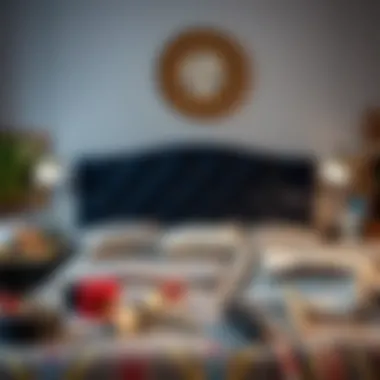

- Materials: Typically crafted from materials like polyester blends or faux leather, contemporary designs prioritize practicality while often offering easy cleaning and durability.
- Colors: A preference for muted colors such as gray, beige, or soft pastels keeps them aligned with modern palettes.
Consider a headboard with a sleek, rectangular shape upholstered in a subtle fabric for a streamlined look that doesn't overwhelm the space. This simplicity allows for various decorative elements, like vibrant bedding or wall art, to shine alongside it.
Classic and Traditional Styles
Classic and traditional upholstered headboards embrace grandeur and nostalgia. They often feature ornate designs, including intricate details such as button tufting or scalloped edges, that hark back to vintage styles.
- Craftsmanship: These headboards generally exhibit superior craftsmanship, frequently using solid wood frames and luxurious fabrics such as silks or rich damasks.
- Color Range: Deep, rich colors like burgundy, navy, or forest green are common, lending a sense of warmth and history to the space.
This style aligns perfectly with homes that boast a more classic interior or desire a cozier aesthetic. A well-crafted piece like this can ground the room, transforming it into a sanctuary of elegance.
Transitional Options
For those undecided between modern and traditional, transitional upholstered headboards present an ideal solution. They combine elements from both styles, allowing for maximum flexibility in design.
- Versatility: You might find a headboard featuring modern shapes adorned with classic fabrics, offering the best of both worlds. This adaptability makes it easier to match existing decor.
- Design Elements: Straight lines may often be softened by a few curves, striking a balance that feels harmonious.
Transitional headboards work well in a variety of spaces, creating an inviting atmosphere perfect for restful retreats. This is a favored choice for homeowners who appreciate contemporary updates while still cherishing timeless elements.
Eclectic and Bohemian Choices
Eclectic and bohemian styles embody a free-spirited approach, celebrating individuality and creativity. Upholstered headboards in this category often feature vivid patterns, diverse textiles, and unexpected color combinations.
- Fabrics and Patterns: You might come across headboards made from a patchwork of fabrics, such as vintage saris or embroidered linens.
- Layering: Layering different textures, like pairing a tufted design with fringe or beaded embellishments, enhances the bohemian feel.
These options encourage personal expression, making them a great fit for those who wish to reflect their unique personality in their space. An eclectic headboard can establish a focal point in a bedroom filled with curated finds from travels or cherished heirlooms.
Choosing the right upholstered headboard is more than just a design decision; it forms a part of your home's narrative. From the knowledge of contemporary lines to the storytelling found in eclectic designs, understanding these styles allows you to create a space that resonates with your taste and elevates your home.
Materials Used in Upholstered Headboards
Choosing the right materials for upholstered headboards is a pivotal decision that impacts both aesthetics and functionality. From the fabric covering to the supportive structures within, every component plays a significant role in how the headboard looks and performs in a bedroom setting. Homeowners, decorators, and DIY enthusiasts alike should consider their options carefully, taking into account factors like durability, maintenance, and overall style.
Types of Fabrics
Velvet
Velvet is a plush fabric that exudes luxury, making it a favored choice for upholstered headboards. Its rich texture adds depth to any space, creating an inviting atmosphere. Velvet's unique characteristic is its ability to reflect light differently depending on the angle, thus altering the appearance as you move around the room. While it can be prone to staining and requires careful cleaning, the comfort it provides is unmatched. For homeowners who prioritize a sophisticated look, velvet is a must-consider fabric.
Linen
Linen is appreciated for its crisp, natural elegance, making it a popular pick for a more relaxed, coastal or contemporary ambiance. Its breathable nature means that it performs well in warmer climates, allowing air circulation to keep things cool. The key attribute of linen is its slight texture, which can add a hint of rustic charm to the bedroom. However, linen can wrinkle easily, which may be a consideration for those who prefer a tidy appearance without fuss. When someone seeks a casually refined look, linen is hard to beat.
Leather
Leather is the embodiment of durability and sophistication, making it an excellent investment material for upholstered headboards. It offers a sleek, polished look that can fit with various design styles, from modern to traditional. The main advantage of leather is its longevity and ease of cleaning, as a simple wipe-down can keep it looking pristine. Nonetheless, it’s worth noting that leather can be susceptible to scratches and might not be ideal for homes with pets. If someone wants a timeless piece that offers both style and practicality, leather makes for a compelling choice.
Microfiber
Microfiber is a man-made fabric that has carved its niche in the world of upholstered furniture. Its soft texture and non-allergenic nature appeal to many households. This fabric is known for its resistance to stains and easy maintenance, which is a significant benefit for busy families or individuals. The downside is that microfiber can sometimes lack the luxurious feel of natural fibers, such as velvet or linen. In essence, for those who seek a low-maintenance option that can stand the test of time, microfiber serves as a strong contender.
Cushioning and Support Structures
Foam Density Options
Foam density options can heavily influence both comfort and longevity when it comes to upholstered headboards. Softer foam provides more cushioning and immediate comfort, making it ideal for lounging or reading in bed. Conversely, firmer foam offers better support, particularly for those who enjoy sitting upright. One major advantage of foam density is the ability to customize comfort levels according to personal preferences, yet it might compress over time if not chosen wisely. For individuals searching for the perfect balance between comfort and support, understanding foam density options is crucial.
Spring Options
Spring options can add a layer of bounce and support, enhancing the user experience. This traditional method has a key characteristic of providing resilient support through coils that conform to body shapes while allowing for some flexibility. It’s popular because it can lead to better posture when sitting against the headboard. However, springs can wear out faster than foam, leading to sagging over time if not properly constructed. For those willing to invest a bit more for enduring comfort, spring options can be invaluable.
Storage Solutions
Storage solutions integrated into the design of upholstered headboards can be a practical consideration for space-conscious individuals. Headboards with built-in shelves or compartments offer extra functionality by reducing clutter in the bedroom and utilizing vertical space effectively. Not only do these options keep essentials within arm's reach, but they also minimize the need for side tables, which can free up floor space. Nevertheless, depending on the design, accessing stored items can sometimes prove awkward. For homeowners keen on optimizing their living areas, these storage solutions can be a game changer.
By selecting the right materials, you not only enhance your bedroom’s style but also ensure long-lasting comfort and utility. Each material and structural option brings its own charm and challenges, so weighing these choices thoughtfully will surely lead to satisfaction with your upholstered headboard.
Customization Options for Upholstered Headboards
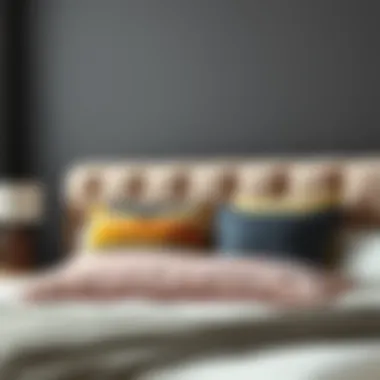
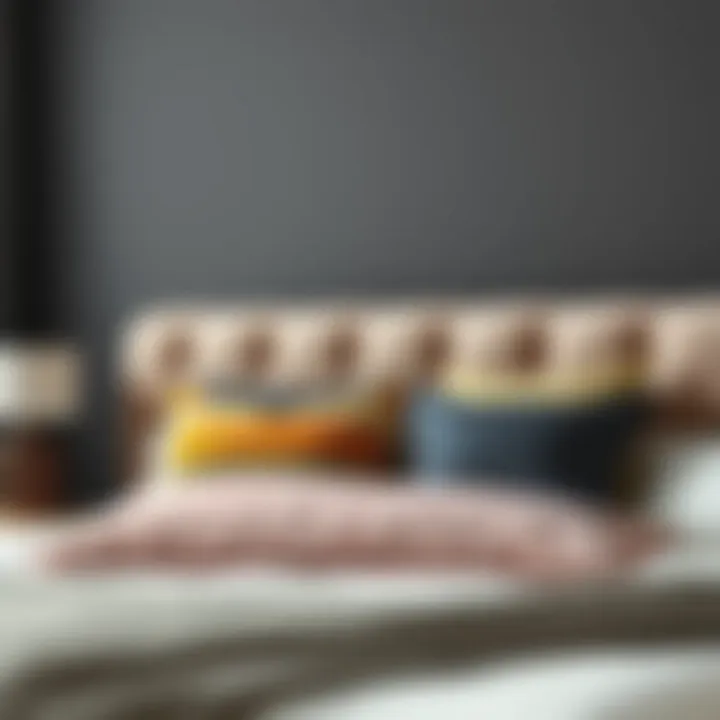
Customization options offer a world of possibilities for homeowners looking to create a unique focal point in their bedrooms. The versatility of upholstered headboards makes them an appealing choice because they can be tailored to fit personal tastes, room dimensions, and overall design aesthetics. This section delves into the various aspects of customization, emphasizing why getting the right dimensions, color schemes, and personalized embellishments can transform a simple piece of furniture into an expression of one’s style.
Dimensions and Sizing
When it comes to upholstered headboards, size does matter. Choosing the right dimensions not only affects the visual balance of the room but also determines functionality. A larger headboard can dominate a space, potentially becoming a dramatic statement piece, while a smaller one can create an intimate feel. Homeowners need to measure their bed size and how much wall space they wish to cover. It’s crucial also to consider the height; a taller headboard can elevate the perceived height of the room and draw the eye upward, giving the illusion of a more spacious environment.
Color and Pattern Selection
Color and patterns can make or break the overall aesthetic of a bedroom. Upholstered headboards are a prime opportunity to experiment with hues and textures that reflect personal style. Darker shades add drama and sophistication, while lighter tones tend to convey a sense of tranquility and openness. Moreover, patterns—be it geometric designs or floral motifs—can bring an additional layer of depth to the decor. When selecting colors and patterns, it’s wise to keep the broader scheme of the bedroom in mind, ensuring harmony between the headboard and other elements like bedding, curtains, and wall colors. This balance is key to a cohesive design.
Personalized Embellishments
Nailhead Trim
Nailhead trim is a popular embellishment that lends an air of sophistication to upholstery. Often made from metal, these decorative accents can highlight the shape and design of the headboard. One of the significant characteristics of nailhead trim is its versatility; it can suit both modern and traditional styles seamlessly. Its ruggedness ensures durability, making it a wise investment for high-traffic areas. However, one should consider the potential for scratches or tarnishing over time, thus requiring occasional upkeep.
Tufting Techniques
Tufting techniques offer texture and visual interest to upholstered headboards. It involves pulling the fabric tight and securing it at various points, creating a padded look with indents. This classic technique emphasizes craftsmanship and attention to detail. The distinct characteristic of tufting is its ability to add depth to the overall design, often making even a simple silhouette feel intricate and luxe. One drawback may be the intricacy involved in cleaning tufted fabrics, as grime can settle in the seams. Nevertheless, the added dimension it brings to a room is often worth the extra maintenance.
Embroidery Options
Custom embroidery is another way to personalize upholstery. This option allows for unique designs, names, or symbols to be sewn into the fabric. The standout feature of embroidery lies in its ability to transform a headboard into a storytelling piece. It can evoke personal memories or represent a family’s heritage, adding sentimental value to the decor. While this adds a distinct touch, it comes with the caveat of potentially limiting future reupholstering options, as the embroidered fabric might need specific care.
"Customization is not just about meeting needs; it’s about creating a space that reflects who you are."
In summary, customization options for upholstered headboards are numerous and cater to various tastes. Homeowners have the freedom to sculpt their desired style through size, color, patterns, and unique embellishments, allowing for a distinctive bedroom decor that stands out.
DIY Upholstered Headboard Projects
Creating a DIY upholstered headboard is not just about function; it's an opportunity to express your personal style and elevate your bedroom's aesthetic. A headboard can transform a mundane sleeping area into a cozy sanctuary. The beauty of a DIY project lies in the freedom to choose your materials, colors, and design, giving you the chance to tailor every detail to your preferences. Furthermore, taking on this project can be considerably more budget-friendly compared to buying a ready-made headboard.
Beyond cost savings, embarking on a DIY upholstered headboard project develops your skills, leading to a sense of accomplishment. While the process requires some planning and elbow grease, the end result can be deeply satisfying. It’s a functional addition to your space, but also acts as a centerpiece — drawing the eye when one walks into your bedroom. Therefore, understanding how to create one successfully is key for homeowners and decorators alike.
Basic Tools and Materials Required
Before rolling up your sleeves, you’ll want to gather everything you’ll need. Here’s a rundown of tools and materials:
- Wooden boards for the headboard base (plywood is commonly used)
- Foam or batting for padding to ensure comfort
- Upholstery fabric in your chosen aesthetic - think about longevity and texture
- Staple gun and staples for fastening fabric to the board
- Electric drill for assembling any necessary components
- Screwdriver for securing fixtures
- Measuring tape to ensure everything fits just right
- Scissors for cutting fabric and foam to size
- Leveling tool to make sure your headboard isn’t at a tilt
Make sure to choose high-quality materials, as they contribute largely to the overall appearance and durability of your finished headboard.
Step-by-Step Instructions
Embarking on your DIY project involves several steps, and taking it step by step makes it manageable. Here's how to build your upholstered headboard:
- Measure and Cut the Wood: Start by measuring the space behind your bed. Cut the wooden board to the desired height and width. A common height is around 48 inches while the width should correspond to the bed size.
- Prepare the Foam: Determine the dimensions for the foam. Cut it to size and lay it on the board to provide padding. It’s advisable to use high-density foam for better longevity.
- Attach the Foam: Use spray adhesive to attach the foam to the wooden board, ensuring it’s smooth and flat. If you prefer, you can use staple gun for a more secure fit.
- Cut and Position the Fabric: Lay the upholstery fabric over the foam, leaving extra material on the sides for folding over later.
- Staple the Fabric: Begin stapling the fabric to the back of the headboard, stretching it taut as you work around the edges. For the corners, carefully fold the fabric to create a clean look.
- Mount the Headboard: Use brackets to attach the headboard to the wall or the bed frame, ensuring it’s secure and stable. Check with a leveling tool that it's straight before finalizing.
- Final Touches: Clean up any loose threads or excess fabric. Stand back, admire your belongings, and enjoy the sense of satisfaction that comes from creating something uniquely yours.
Mistakes to Avoid
Despite the allure of DIY, common missteps can lead to dissatisfaction or a headboard that doesn’t fit well. Keep these pitfalls in mind:
- Incorrect Measurements: Double-check your measurements before cutting anything. Measure not once but twice; cutting incorrectly can lead to wasted materials.
- Ignorance of Materials: Not all fabrics are suitable for upholstery. Avoid thin or delicate materials as they may wear out quicker.
- Skipping Padding: A headboard without sufficient padding tends to be uncomfortable. Take time to select quality foam or batting.
- Poor Margin for Error: Don't cut fabric too close to the board edges — you'll need excess material to tuck and wrap around the edges nicely.
- Neglecting Installation: Ensure that whatever mounting system you choose is sturdy, especially if you have pets or kids.
Taking preventive measures can save you a headache down the line, allowing you to enjoy your new creation for years to come.
By undertaking a DIY upholstered headboard, you are not just improving your bedroom's look; you are weaving a personal narrative into your living space, creating something that resonates with your style and sensibilities.
Care and Maintenance of Upholstered Headboards
The essence of an upholstered headboard goes beyond its visual appeal; it embodies functionality and comfort. However, like any piece of furniture, attention is needed to maintain its charm and longevity. This section provides insights into why caring for your upholstered headboard is crucial, touching on specific cleaning techniques and preventive measures that every owner should consider. Without proper care, even the most elegant headboard can become dingy and worn, diminishing the overall aesthetic of your bedroom.
Cleaning Techniques
Keeping an upholstered headboard clean is a blend of the right techniques and regularity. Here’s how to approach it:
- Vacuum Regularly: Use a soft brush attachment on your vacuum cleaner to pick up dust mites, pet hair, and other debris. Make sure to do this at least once a month.
- Spot Clean with Care: Any stains that may show up should be treated immediately. A mild detergent mixed with water can be applied with a clean cloth. Remember to dab, not rub, to avoid fabric damage.
- Steam Cleaning: For deeper cleaning, consider using a steam cleaner according to the fabric's safety guidelines. This method can effectively lift dirt and refresh the fabric without making it overly wet.
- Professional Cleaning: Depending on the fabric and its condition, you might want to hire professional cleaners who specialize in upholstered items. They often have solutions tailored for delicate fabrics.
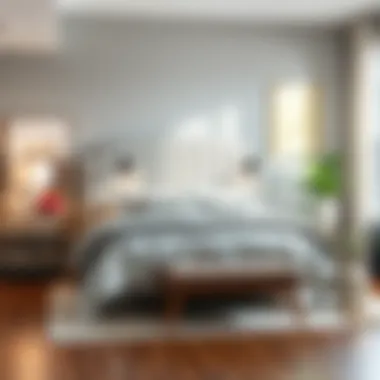
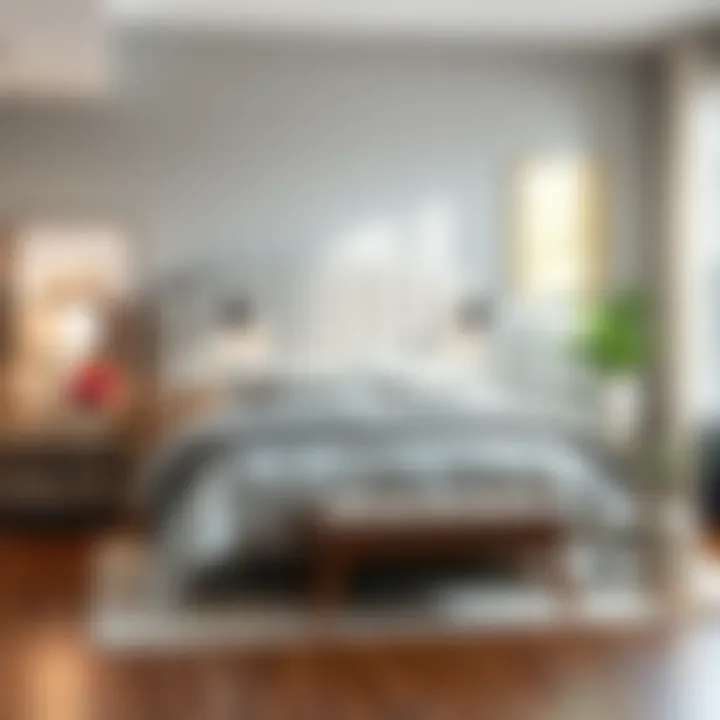
"Regular cleaning not only extends the life of your headboard but also enhances the overall bedroom atmosphere."
Preventive Measures
To keep your upholstered headboard looking fresh and new, here are some preventive measures that can be easily integrated into your routine:
- Avoid Direct Sunlight: Positioning your headboard away from direct sunlight can prevent color fading over time. If possible, use blinds or curtains to shield it.
- Use Fabric Protectors: Applying a fabric protector can assist in minimizing stains and spills, making future cleaning much easier. Be sure to choose a product compatible with your specific fabric.
- Limit Heavy Usage: If your headboard is frequently used as a leaning area, consider placing decorative cushions or pillows to take on some of that wear and tear.
- Maintain Humidity: Excessive humidity can damage fabrics; using a dehumidifier may help maintain the right environmental conditions for your upholstered piece.
By paying heed to these cleaning techniques and preventive measures, you can ensure that your upholstered headboard continues to be a focal point of elegance in your bedroom while serving its purpose effectively for years to come.
Trends in Upholstered Headboards
The landscape of interior design is ever-evolving, and upholstered headboards are no exception. They serve as both functional and aesthetic components in bedrooms, making them crucial in home decor. It's vital to stay updated with trends in upholstered headboards to ensure your bedroom reflects current styles while maintaining comfort and character. This section explores the key trends shaping upholstered headboards today.
Current Design Trends
Upholstered headboards have witnessed a renaissance in design, which is full of variety and innovation. A few notable current trends include:
- Heightened Backrests: More homeowners are opting for taller headboards. These statement pieces not only provide added support but also frame the bed spectacularly, making it the focal point of the room.
- Bold Patterns and Textures: Gone are the days when neutrals ruled the roost. Today's headboards flaunt vibrant florals, geometric patterns, and even animal prints. These bold choices can inject personality into a bedroom, breaking up monotony and adding visual interest.
- Minimalist Aesthetics: On the flip side, some homeowners lean towards sleek, minimalist designs. Straight lines and subtle shades with occasional tufting or piping create a clean look that effortlessly complements modern decor.
- Curved Shapes: The resurgence of rounded headboards offers a softer approach in design. The gentle curves and flowing lines create a welcoming ambiance, often paired with a plush fabric to enhance comfort and style.
Additionally, layered bedding paired with these innovative headboards creates a cozy and inviting atmosphere. Home decorators are combining various materials and decorative techniques to achieve a personalized look.
"Headboards are more than just aesthetic; they act as the central piece around which bedroom decor revolves."
Sustainable Materials and Practices
With increasing awareness around environmental impact, sustainable choices in upholstered headboards are gaining traction. The shift toward eco-friendly materials reflects a broader commitment to sustainability in design. Consider the following:
- Organic Fabrics: Fabrics like organic cotton and hemp are becoming popular. They not only come with a smaller carbon footprint but also provide safe and healthy choices for the home environment.
- Reclaimed Wood Frames: Instead of new wood, some headboards are framed with reclaimed timber. This practice not only adds character but also promotes recycling and reduces waste.
- Non-Toxic Upholstery: Look for headboards using non-toxic adhesives and finishes. These materials are safer for both residents and the environment.
- Diverse Sourcing: More designers are sourcing materials locally to reduce transportation emissions. This approach supports local economies while minimizing the ecological footprint.
The movement towards sustainability is not just about materials; it extends into the entire design process. Professionals are prioritizing longevity and functionality in upholstery design to reduce waste associated with disposable furniture.
By keeping these trends in mind, homeowners and decorators alike can create stunning spaces that honor both style and the environment.
Integrating Headboards with Bedroom Design
In the world of interior design, the bed is often the centerpiece of the bedroom, and the headboard plays a crucial role in this dynamic. Integrating upholstery into this equation adds layers of elegance and personality. It’s not merely about having something to lean against; it’s about how this functional piece can set the tone for your entire space. An upholstered headboard can effortlessly tie various elements together, making your bedroom feel cohesive and thoughtfully designed.
Color Coordination and Aesthetics
When it comes to aesthetics, color coordination is key. The upholstery on the headboard should complement or contrast harmoniously with the surrounding decor, creating a balanced visual experience. For example, a bold, patterned headboard can serve as a striking focal point against neutral walls and bedding. Alternatively, a soft, muted fabric can lend a calming effect, enhancing the room's overall tranquility.
Consider the following when selecting colors for your upholstered headboard:
- Wall Color: Choose tones that either match or contrast pleasingly with your walls. Warmer colors can evoke coziness, while cooler shades may enhance serenity.
- Bedding and Accessories: Take into account any existing textiles in the room. A well-chosen headboard fabric can complement duvet covers, throw pillows, and other decorative elements seamlessly.
- Lighting: Different hues interact uniquely with light. Ensure that the headboard fabric reflects the intended mood—soft colors can feel warm under lamp light, while bolder shades might pop under natural illumination.
Incorporating textures too, such as a plush velvet or a sleek leather, can add dimension and depth to the design. Not only does the color palette matter, the texture plays a role in how the overall atmosphere is perceived.
"A headboard is not just a piece of furniture; it's a canvas for your personal style."
Furniture Arrangement
Furniture arrangement in relation to an upholstered headboard can be a gamechanger. The layout of the room influences functionality, flow, and comfort. Positioning your bed effectively around its headboard can enhance not just aesthetics, but also usability. Here are some considerations:
- Proximity to Nightstands: Ensure that the headboard's height and design accommodate bedside tables. The visual and physical relationship between the two should feel intentional, not cramped or awkward.
- Traffic Flow: The placement of the bed should allow for easy movement within the room. Avoid building a fortress around the headboard; it should invite you in rather than obstruct.
- Symmetry vs. Asymmetry: Decide if you want a balanced look or something more eclectic. A symmetrical setup, with identical lamps or decorations on either side of the headboard, tends to create harmony, whereas asymmetrical arrangements can add interest.
- Consider Space Utilization: If space is tight, look into headboards with built-in storage. This integration allows for maximizing space while adding to the visual appeal of the room.
Taking a step back and viewing the arrangement from a distance could help you assess whether the headboard integrates well within the broader context of the room. It’s like painting a picture: every element needs to play its part to create a masterpiece.
Closure: The Role of Upholstered Headboards in Home Decor
Upholstered headboards have made a significant mark in modern bedroom decor. They are more than just a backrest for your pillows; they bring an element of style and sophistication to any space. Their role extends beyond aesthetics; they assist in creating a cozy atmosphere and improve overall comfort. By selecting the right headboard, homeowners can adapt their bedroom's look to reflect personal style, whether it leans towards classic elegance or contemporary minimalism.
Summary of Benefits
In contemplating the value of upholstered headboards, several key benefits stand out:
- Aesthetic Versatility: Upholstered headboards come in various styles, colors, and materials. This variety enables homeowners to choose options that align with their room's theme. From tranquil grays to vibrant blues, the fabric choices are endless.
- Enhanced Comfort: The cushioned nature of these headboards provides support for sitting up in bed, whether you're reading or watching a late-night movie. This enhances relaxation and maximizes comfort when enjoying your sleeping space.
- Sound Dampening: The upholstered materials contribute to reducing noise, creating a quieter sanctuary for rest. They help absorb sound, ensuring your sanctuary remains calm and peaceful.
- Easy Customization: With options for colors, patterns, and finishes, upholstered headboards offer easy ways to refresh a bedroom's look without undertaking a full redesign. Homeowners can also incorporate personal touches like tufting or embroidery to reflect their taste.
Final Thoughts
As we draw this exploration to a close, it’s apparent that upholstered headboards are not just furniture accessories; they are vital components of bedroom design. They marry functionality with design, bridging the gap between comfort and style. Delving into the world of upholstered headboards opens up a plethora of creative possibilities.
Investing in a quality upholstered headboard can transform a mundane bedroom into a stylish retreat. When choosing one, consider not just the overall decor but also how it will enhance daily living. Ultimately, an upholstered headboard can be a worthy centerpiece, bringing together cohesion and comfort without compromising on your aesthetic vision.
"The right headboard can make or break the feel of a room. Choose wisely."















